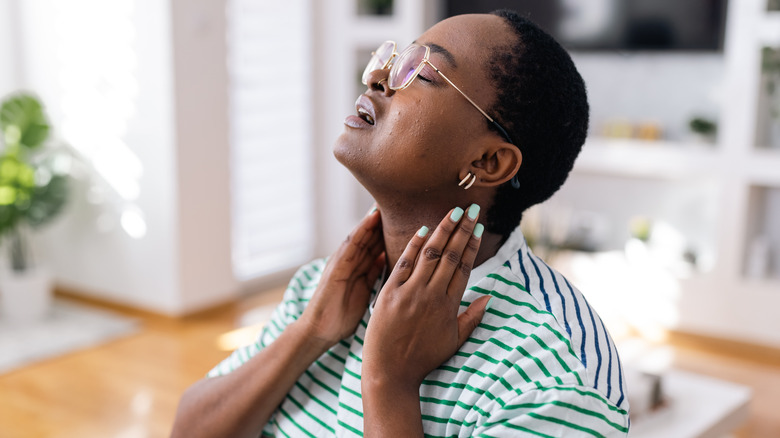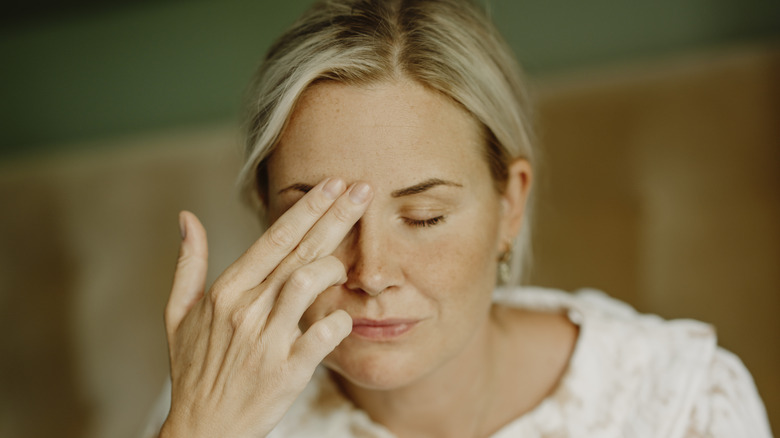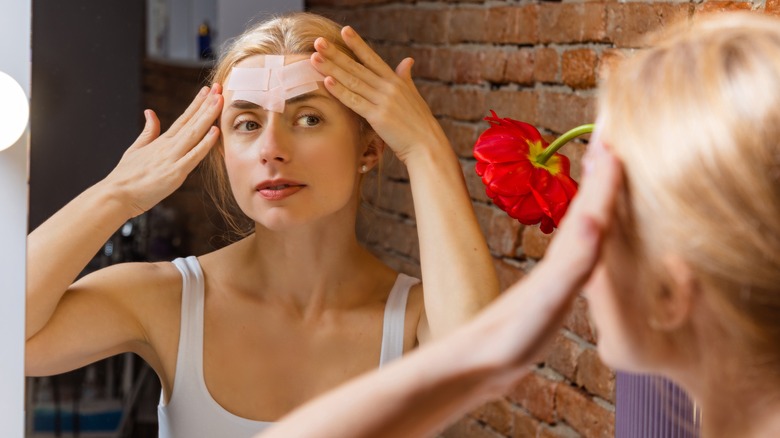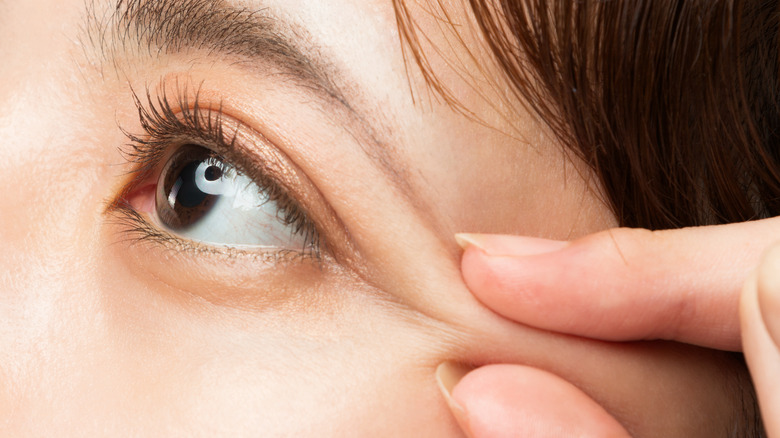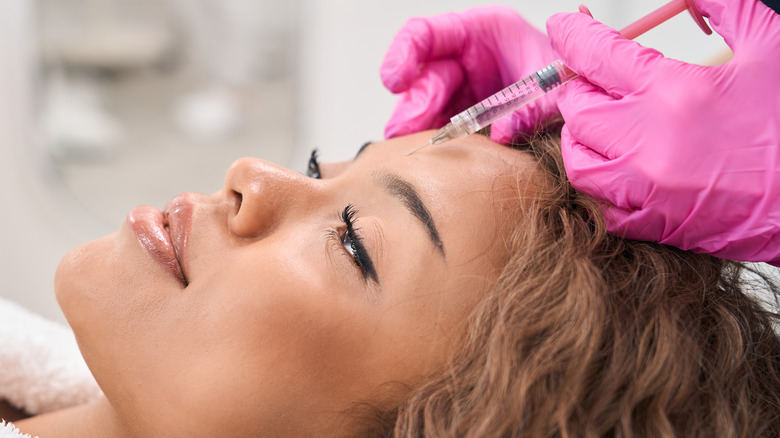Tips For Relaxing Your Eyebrow Muscles & Letting Go Of Tension
We live in a culture where everything is go, go, go. As much as we may try to slow down and take a breather, we're not always able to do that. In fact, even when we think we're relaxing, we actually might not be relaxing at all. For example, bring your attention to your jaw right now. Are you clenching it or is it happily slack-jawed? For many of us, it's probably the former.
"Stress manifests in the face first, and the spine and body follow, versus the other way around," Rachel Lang, a skin care specialist and co-founder of Facelove, tells Goop. Whether due to poor posture or stress, many of us find ourselves in an often hunched position. "The modern version of upper-body tension is caused by tilting our heads to look into our gadgets," says Lang. When we hold all this tension in our jaw, neck, and shoulders, we automatically hold it in our brow too.
It's only when we let go, release the jaw tension, and feel our face droop that we realize just how much stress and anxiety we hold in our head. But even when we realize it, getting to the point where our eyebrow muscles are completely relaxed and tension is released isn't exactly easy. However, once you're cognizant of how you're holding your face when you think you're resting, you'll be more aware of enacting tips to relax those eyebrow muscles and let some of that physical stress go.
Adjust your tongue posture
Like the rest of your body, there is a proper way to hold your tongue when it's relaxed. You may not have noticed it, but when your jaw is clenched the tongue is trapped behind the teeth in a place where it's technically not supposed to be. "Your tongue should be touching the roof of your mouth when resting," dentist Dr. Ron Baise tells Healthline. "It should not be touching the bottom of your mouth. The front tip of your tongue should be about half an inch higher than your front teeth."
When you do practice correct relaxed-tongue placement, allow for there to be a space between the upper and lower teeth with your lips closed — see how relaxed your jaw is now? That's the tongue posture you should be trying to maintain as much as possible to avoid unnecessary tension throughout your face, head, and especially eyebrows. It might seem strange that tongue posture would affect your ability to relax (or not relax) your eyebrow muscles, but since everything in that part of the body is related it goes hand-in-hand. All you need is one thing not functioning at its best, your tongue in this case, for the surrounding parts of the body to suffer. A tongue that can't relax leads to a clenched jaw, which leads to scalp pain and tightness across the forehead which, in turn, can cause tension headaches, per Thrive Integrated Physical Therapy.
Stretch out your neck regularly
Because our neck and head are very much in bed together — one can't exist without the other after all — tension-type headaches (TTH) can occur due to tight neck muscles which disallow the eyebrow muscles from being able to fully relax. According to a 2008 study published in the British Medical Journal, tension headaches can be linked to head and neck neurons that have become hyperexcitable. Basically this means that the neurons, in getting off track and becoming somewhat irritable, are acting out and tightening up. Misery loves company, and so these neurons spread their pain in the form of a headache across the brow.
A good way to help relax those eyebrow muscles is by starting with the neck and shoulders. In other words, improving your posture. When your shoulders are relaxed and the back is lengthened, your face and head muscles will follow suit, falling into their proper place. On the days when your eyebrow muscles are extra tense, stretching your neck and feeling for knots that can be worked out will help. Place your pointer and middle finger on the area of the neck that's tight, and apply pressure while massaging in circular motions. Then do it again in the opposite direction until things begin to feel looser. You'll feel tension release up along your neck, to your temples, and right into your eyebrow muscles.
Vibrate your cheek muscles
There's a reason why vibrating facial massage tools exist: They work. In fact, the use of vibration therapy has become popular in recent years because of its positive impact when used on the whole body or localized points. When vibrations are applied to the skin, they increase blood flow, aid in pain relief, and stimulate the muscles in such a way that they contract and ultimately relax, per BrownMed.
But this doesn't mean you need to make an appointment for vibration therapy or run out and buy an expensive vibrating tool to use at home. Instead, simply taking a deep breath so your cheeks are fully inflated, then breathing out completely and explosively (read: like a frustrated child) will give your cheek muscles a vibrating massage which will help your neck and head muscles relax. "There are many muscles that attach your jaw to different parts of your skull and neck, and facial massage can help to reduce the tone in those muscles to assist in getting it moving again," physiotherapist David O'Brian tells The Guardian.
When vibrating your cheeks, let your mouth do its thing, without restraining it. So what if a little spit comes blowing out of your pursed lips? You're releasing tension in your facial muscles, specifically your jaw and eyebrows, and that's what matters most.
Regularly practice the emotional freedom technique (EFT)
Colloquially called facial tapping, EFT is a form of acupuncture in which meridian points along the face are tapped while saying your thoughts aloud. It might sound a little hokey, but according to a 2019 study published in The Journal of Evidence-Based Integrative Medicine, EFT can lower levels of distress, anxiety, and depression. A 2016 study published in EXPLORE: The Journal of Science and Healing showed that EFT is also a reliable treatment for PTSD.
"What it does better than any [technique] I've seen is it quickly takes down your physical and emotional dysregulation," licensed clinical social worker and master EFT trainer Robin Bilazarian tells Mind Body Green. "It kicks us from the sympathetic nervous system of fight or flight into the parasympathetic nervous system of rest and digest, and it does that so quickly." It also encourages blood flow which is important in relaxing tense head and face muscles.
When practicing EFT, there are nine points you should tap with medium pressure while picturing and verbalizing the problems that are causing stress and anxiety. Those nine points are between the eyebrows, outside the eye, under the eye, under the nose, on the chin, on the collarbone, the top of the head, under the arms, and the outside of your hand (the pinky finger side). Tap each point with both your index and middle finger, and move from one acupoint to the next while breathing in a calm, relaxing way. Bring the tapping back to between your eyebrows often to release the tension located there.
Massage your forehead
If you've ever started rubbing your forehead and applying pressure to your temples, making circular motions in hopes of de-stressing, you were definitely on to something. It felt good, didn't it? What you may not have realized is that you were benefiting from skin rolling, or at least a modified version of it. Skin rolling helps loosen the skin so it's less restricted, meaning the tension is released. It also decreases pain in the areas that are rolled, and increases muscular flexibility that spreads across the area — a flexible eyebrow muscle is one that's at peace.
When skin rolling on your face, you want to start at your jaw (the tension holder of all tension holders!), then lightly pinch the skin while rolling up the side of the cheek to the temple. Here, you can linger and massage those temples, as you probably do regularly when you're stressed out. With this rolling and pinching, you're boosting blood circulation, an essential component for releasing tension. Don't forget to do both sides for optimal benefits. Your eyebrow muscles will be better for it.
Place tape across your forehead
Before you start thinking that this is some whack-a-doo idea, open your mind to the possibility that, yes, tape on your forehead can actually help relieve tension in your eyebrow muscles. But we're talking about Kinesio tape here. Please don't reach for packaging tape; it needs to be skin-friendly. According to a 2021 study published in the PLoS ONE journal, when Kinesio tape was applied to parts of the body struggling with pain, for example a headache, the participants felt relief. However, to get the most out of the tape application, it needs to be applied with tension so it can actively affect sensory receptors.
"All of your tissues — skin, connective tissue, fascia, muscles — contain sensory receptors that feel pain, temperature, and touch," board-certified clinical specialist in sports physical therapy Dr. Megann Schooley tells Healthline. "Those receptors all contribute to proprioception — your brain's sense of where your body is and what it's doing. Kinesiology taping creates a lift that unloads the underlying tissues. Decompressing those tissues can change the signals going to the brain. When the brain receives a different signal, it's going to respond differently."
In addition to easing pain, it can also benefit your posture and decrease furrowing. If you apply the tape to your neck or between your eyebrows, when you slouch or scowl you'll feel the tape move, so you're reminded to sit up straight and relax your brow, both of which will help with dispersing tension and pain.
Give your eyebrows some love
Since we are talking about eyebrow muscles, after all, it would be remiss to not delve into actual eyebrow massages. We've covered everything that affects eyebrow tension, but let's get to the heart of the matter. Not only are eyebrow massages great for stress and tension, but when you're suffering from those awful all-over face and headaches because of allergies or colds, eyebrow massages can come to your rescue. Pinching and massaging the brow both increases blood flow and gets those toxins running for the hill.
"Press your thumbs firmly towards each other and into the bridge of your nose, just underneath your forehead," massage therapist Clinton Kyles tells Well + Good. "Hold this for three deep breaths and release slowly and repeat as needed." Slide your fingers to the end of your eyebrows, then to the temples with your index fingers. "Lastly, interlace the fingers on the forehead and eyebrows and sweep them open into the temples, applying more targeted pressure to the area," says Kyles. If you don't have a headache at the moment, a quick eyebrow pinch will give you a gentle, refreshing jolt so you can take on whatever the day has in store for you.
Make an appointment for Botox
When our face and head rebuff our attempts at home remedy techniques, it's time to go for toxins. Or, more specifically, injected botulism in the form of Botox. You may have already heard of people getting Botox for migraines and tension headaches, but you can also get it for temporomandibular joint disorder. According to a 2016 study published in The Journal of Headache and Pain, Botox has been proven effective in relaxing the masseter muscles in the jaw, thereby treating the pain that comes with a clenched jaw and the tension headaches that are the result of the jaw clenching. In other words, if all else fails, there's always Botox.
Since learning to relax our facial muscles is a feat for many of us, having these tips to turn to can be really beneficial. Because not every technique will automatically work for everyone, it will take some trial and error to see which one is the best for you. But don't worry, at least one will pull through, and you and your eyebrow muscles will be happier for it.


